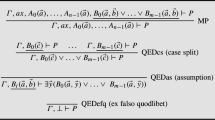Abstract
We describe a complete theorem proving procedure for higher-order logic that uses SAT-solving to do much of the heavy lifting. The theoretical basis for the procedure is a complete, cut-free, ground refutation calculus that incorporates a restriction on instantiations. The refined nature of the calculus makes it conceivable that one can search in the ground calculus itself, obtaining a complete procedure without resorting to meta-variables and a higher-order lifting lemma. Once one commits to searching in a ground calculus, a natural next step is to consider ground formulas as propositional literals and the rules of the calculus as propositional clauses relating the literals. With this view in mind, we describe a theorem proving procedure that primarily generates relevant formulas along with their corresponding propositional clauses. The procedure terminates when the set of propositional clauses is unsatisfiable. We prove soundness and completeness of the procedure. The procedure has been implemented in a new higher-order theorem prover, Satallax, which makes use of the SAT-solver MiniSat. We also describe the implementation and give some experimental results.
Access this chapter
Tax calculation will be finalised at checkout
Purchases are for personal use only
Preview
Unable to display preview. Download preview PDF.
Similar content being viewed by others
References
Andrews, P.B., Bishop, M., Brown, C.E.: System description: TPS: A theorem proving system for type theory. In: McAllester, D. (ed.) CADE 2000. LNCS, vol. 1831, pp. 164–169. Springer, Heidelberg (2000)
Andrews, P.B., Brown, C.E.: TPS: A hybrid automatic-interactive system for develo** proofs. Journal of Applied Logic 4(4), 367–395 (2006)
Backes, J., Brown, C.E.: Analytic Tableaux for Higher-Order Logic with Choice. In: Giesl, J., Hähnle, R. (eds.) IJCAR 2010. LNCS, vol. 6173, pp. 76–90. Springer, Heidelberg (2010)
Benzmüller, C.E., Paulson, L.C., Theiss, F., Fietzke, A.: LEO-II - A cooperative automatic theorem prover for classical higher-order logic. In: Armando, A., Baumgartner, P., Dowek, G. (eds.) IJCAR 2008. LNCS (LNAI), vol. 5195, pp. 162–170. Springer, Heidelberg (2008)
Brown, C.E., Smolka, G.: Analytic tableaux for simple type theory and its first-order fragment. Logical Methods in Computer Science 6(2) (June 2010)
Eén, N., Sörensson, N.: An extensible sat-solver. In: Giunchiglia, E., Tacchella, A. (eds.) SAT 2003. LNCS, vol. 2919, pp. 333–336. Springer, Heidelberg (2004)
Korovin, K.: iProver – an instantiation-based theorem prover for first-order logic (System description). In: Armando, A., Baumgartner, P., Dowek, G. (eds.) IJCAR 2008. LNCS (LNAI), vol. 5195, pp. 292–298. Springer, Heidelberg (2008)
Pfenning, F., Schürmann, C.: Algorithms for equality and unification in the presence of notational definitions. In: Altenkirch, T., Naraschewski, W., Reus, B. (eds.) TYPES 1998. LNCS, vol. 1657, pp. 179–193. Springer, Heidelberg (1999)
Smullyan, R.M.: A unifying principle in quantification theory. Proceedings of the National Academy of Sciences, U.S.A 49, 828–832 (1963)
Sutcliffe, G.: The 5th IJCAR Automated Theorem Proving System Competition - CASC-J5. AI Communications 24(1), 75–89 (2011)
Sutcliffe, G., Benzmüller, C.: Automated Reasoning in Higher-Order Logic using the TPTP THF Infrastructure. Journal of Formalized Reasoning 3(1), 1–27 (2010)
Author information
Authors and Affiliations
Editor information
Editors and Affiliations
Rights and permissions
Copyright information
© 2011 Springer-Verlag Berlin Heidelberg
About this paper
Cite this paper
Brown, C.E. (2011). Reducing Higher-Order Theorem Proving to a Sequence of SAT Problems. In: Bjørner, N., Sofronie-Stokkermans, V. (eds) Automated Deduction – CADE-23. CADE 2011. Lecture Notes in Computer Science(), vol 6803. Springer, Berlin, Heidelberg. https://doi.org/10.1007/978-3-642-22438-6_13
Download citation
DOI: https://doi.org/10.1007/978-3-642-22438-6_13
Publisher Name: Springer, Berlin, Heidelberg
Print ISBN: 978-3-642-22437-9
Online ISBN: 978-3-642-22438-6
eBook Packages: Computer ScienceComputer Science (R0)




